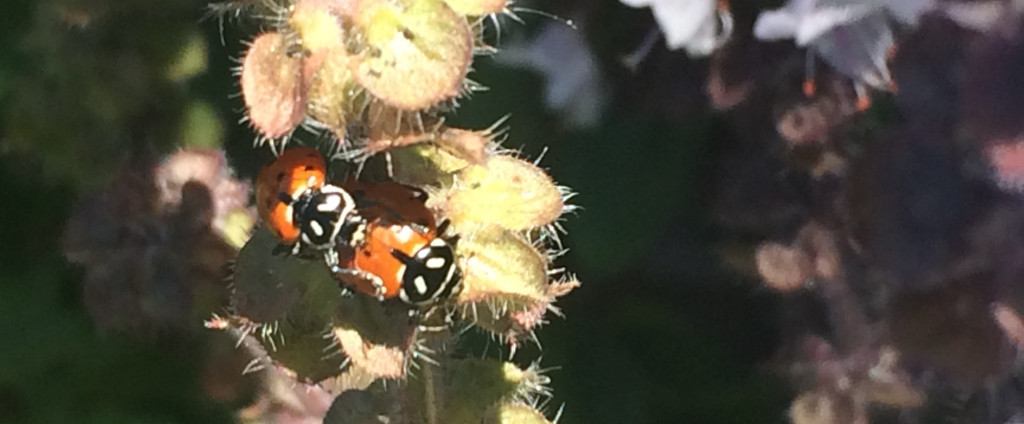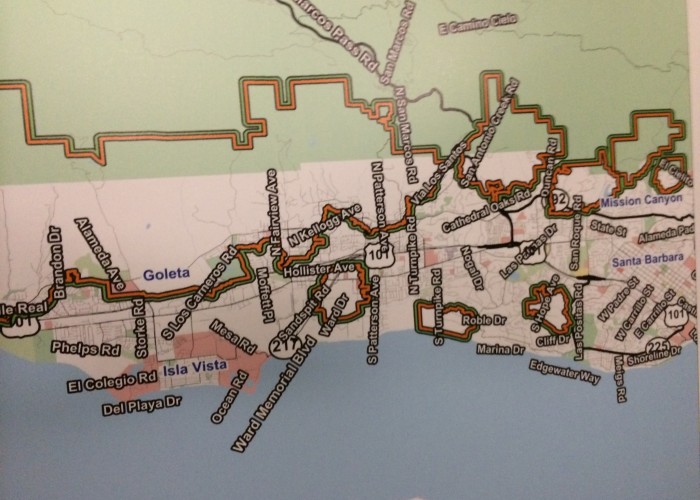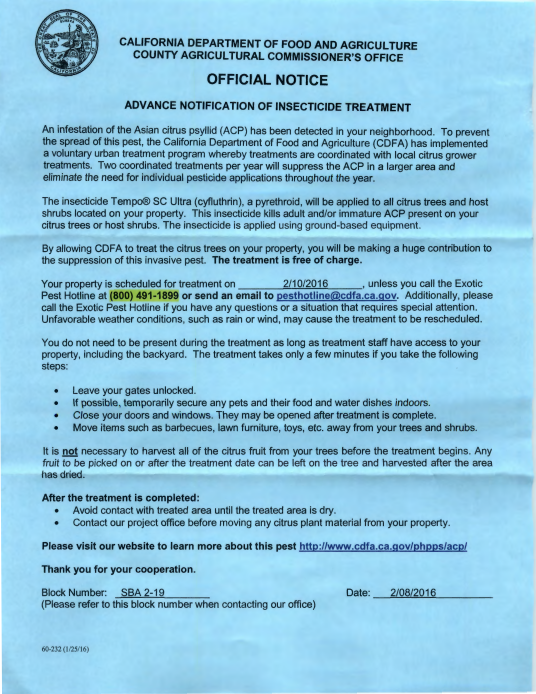Situation:
Pesticide is being sprayed in backyards with citrus trees all around Santa Barbara County starting this week.
The pesticide is a broad spectrum synthetic cyfluthrin spray, and will be followed in June by soil drenching of systemic imidacloprid neonicotinoid pesticide.
The initiative is being implemented by the Santa Barbara County Ag Department to control the Asian Citrus Psyllid (ACP).
Background:
Homeowners were contacted via letters, and the program was announced this past Monday Jan 18th (a public holiday).
At the ‘community meetings’ held in a small hotel conference room, the program was marketed by the county as the only possible way to control the spread of the ACP and prevent an outbreak of HLB, a serious citrus disease.
HLB was detected in California in 2012. It came via an infected lemon tree stem smuggled into the state, and grafted on a backyard citrus in the Hacienda Heights area of Los Angeles.
In July 2015 in San Gabriel, 15 miles away from the original detection, the CDFA detected a kumquat tree with HLB, then a Lime next door, as well as a Calamondin and a Mandarin nearby, and an additional 7 trees. The trees were removed. [1] [2] [3] [4]
Cyfluthrin is a broad spectrum contact pesticide made by Bayer (sold as Tempo SC Ultra).
Imidacloprid also made by Bayer (sold as Merit 2F), is a systemic pesticide applied by soil drenching.
Imidacloprid can persist for many years in trace amounts, and has been linked to the death of honeybees. [4] [5]
This plan targets home owners only, private citrus growers must hire their own spray companies.
Neither the letter to homeowners, nor the public meeting, mentioned any means for residents to opt out of the spraying. Trusted local media group Noozhawk cites:
“Homeowners can call the the California Department of Food and Agriculture at 800.491.1899 to opt-out of the treatments.” [6]
The full plan and justification is documented here [7]
Assessment:
Many locals, and our team believe this strategy is misguided. [8] [9]
The approach presents plausible risk to dogs, cats and bees.
The Pesticide Research Institute and Vetenarians advise that both Cyfluthrin and Imidacloprid should be avoided. [10] [11]
Cyfluthrin: “Highly toxic to cats, and toxic to the nervous systems of pets and people. Many of these compounds, including permethrin, are classified by the EPA as Likely or Possible carcinogens. People can become sensitized to pyrethroids, triggering asthma or allergic reactions. Some pyrethroids are suspected endocrine disruptors. Pyrethroids are highly toxic to bees. Flea resistance is also an issue for effectiveness.” [10]
Imidacloprid: “May be toxic to the nervous systems of pets and people, though insects are more susceptible. Highly toxic to bees. [10]
The CSDA justification [6] also completely ignores safer organic approaches.
There are well studied biological controls of ACP including natural native predators such as ladybugs, syrphid fly larvae, lacewing larvae and spiders. [12] [13] [14]
The document does not even mention the role Argentinian ants play in supporting ACP.
Ants farm psyllid larvae, and attack ACP predators, yet can be countered by backyard gardeners very simply using Tanglefoot on tree trunks. [15] [16] [17]
In the community meeting, local Ag Dept representatives were not clearly identifiable in the crowd.
In conversation, the representatives presented alternative treatments as ineffective, and claimed that Bayer’s pesticides were the only option.
The biological control they were aware of was Tamarixia Radiata (a predatory wasp), which was dismissed as ineffective and far too expensive at “$1/wasp”. [18]

The “Community Meeting” was little more than a series of poster boards in a small crammed conference room at a local hotel.
Local community leaders were also sent emails from grower representatives implying that HLB had again been discovered in Hacienda Heights, to support that urgent spraying in Santa Barbara was necessary.
Subject: HLB-positive psyllid found in LA CountyDate: January 22, 2016 at 9:32:35 AM PSTTo: undisclosed-recipients:;An adult psyllid has tested positive for the HLB disease in Los Angeles County. The psyllid was collected during routine surveys within the HLB quarantine area near Hacienda Heights. Extensive sampling of citrus trees (and ACP) in that area is underway and so far all of the citrus trees (and additional ACP) tested have been negative. Details are posted on the Citrus Insider website:Also on that site is an article about area wide management for ACP. It reminds us that in Florida they did not begin area wide management until after HLB became established. By contrast, California growers are beginning area wide management as soon as ACP is established and well before HLB shows up in orchards. And that, as the article’s title states, is why coordinated, area wide sprays for ACP will work for California.Regards,
The report seems to have originated from the UCANR blog [19], and is copied on the Citrus Insider website.
No press release regarding the incident is present on the official CDFA website as of 2/8/2015. [20]
The new report follows the original HLB incident from 2012 [21].
It could be that PCR analysis, a DNA test for the HLB bacteria, is showing results meeting threshold levels for actual positive detection. [22]
Given the San Gabriel HLB detection in July last year, which really should have been part of the information being shared, HLB may have been again detected in Psyllids in Hacienda Heights area.
Psyllids live for 2 months, and acquire HLB from an infected tree, so if they’re testing positive, it’s reasonable to expect that HLB has been in the area in the last 2 months. [23]
In other meetings, local leaders are being told there are “no natural predators” of ACP and that the county plan is the only possible course of action.
The CSDA and local Ag Dept were seemingly ignorant of organic options and strategies, and influenced by the Big Pesticide approach.

These natural predators in the fight against ACP look a lot better for the environment than the alternatives.
In the long term, applying broad spectrum and systemic pesticides has another cost.
Pesticide spraying weakens the biological controls already battling ACP (lace wings, spiders, ladybugs etc) [24].
This in turn may force the Ag department into a cycle of regular re-application of more and more pesticides.
In Florida, this was called ‘the pesticide treadmill’. [25] [26]
Recommendation:
- Anyone with citrus in their back yard should act immediately and inspect their tree for ants, and use Tanglefoot to prevent ants farming and protecting Psyllids.
- Citrus owners should inspect for ACP now, and in the spring, look for ACP larvae. The method should be part of a public education program. Our good friends at Super Bee Rescue have provided a helpful link to UC Riverside’s Resource. [27]
- Biological control with commercially available ladybugs and lacewings should be promoted as a community choice, or “opt in” program. [10] [28]
- If ACP is found, where biological controls have been ineffective, spraying trees with organic controls such as horticultural oil and insecticidal soap should be next step.
- The Ag dept should focus on pet, bee, and environmentally friendly, sustainable approaches to managing ACP.
Final Thoughts: We have a choice.
We can choose a future where synthetic pesticides are sprayed on trees and systemically saturate the soil to kill everything other than the GMO foods designed to withstand them.
Or we can choose an ecologically diverse and balanced system where ladybugs, lacewings, earthworms and healthy trees are encouraged to keep the critters in check.
We believe enabling organic solutions is the best path to long term sustainability and a healthy environment.
We will be monitoring the health of bees in Santa Barbara County with the EyesOnHives platform.
Our company is dedicated to giving beekeepers (and in the future farmers and others) increased visibility into the health of their bees and plants, to enable smarter decision making, and sustainable solutions.
Inspiration Material on ACP Management
Systemic Pesticides not effective long term for ACP. Biological Control sustainable, available, and likely already present in healthy trees:
https://www.birc.org/Psyllid.pdf
“Protection of mature trees is unreliable, and psyllid mortality is about 50%-70% both from foliar sprays and trunk injections (Ichinose et al. 2010ab). Because psyllids often receive sublethal doses, resistance to neonicotinoids is likely to build quickly. Another problem is that liberal use of systemics and other pesticides has not stopped the psyllid in Florida (Boina et al. 2009; Hall et al. 2013).”
“Major biocontrols include spiders, ladybugs, syrphid fly larvae, lacewing larvae, and the parasitoid Tamarixia radiata… Biological control was effective in controlling huanglongbing on Réunion Island, and organic growers in Florida have had success. Some commercial biocontrols are available (see Resources). Major predators in Florida are ladybugs such as Harmonia axyridis that can cause 80-100% psyllid mortality.”
Backyard Growers can Help Predatory Insects attack ACP by impeding ants:
https://californiacitrusthreat.org/tamarixia-radiata.php
“One way owners of citrus trees can help improve the effectiveness of Tamarixia is by placing ant bait around citrus trees and keeping trees well pruned. Ants can interfere with beneficial insects like Tamarixia and actually protect harmful pests like the Asian citrus psyllid.”
Ladybugs, Lacewing & other organic controls for ACP are promising.
https://www.crec.ifas.ufl.edu/
References
[3] https://www.cdfa.ca.gov/egov/Press_Releases/Press_Release.asp?PRnum=15-031
[4] https://www.unaf-apiculture.info/presse/Bonmatin154.pdf
[5] https://www.ncbi.nlm.nih.gov/pmc/articles/PMC4284396/
[7] https://www.cdfa.ca.gov/plant/pdep/treatment/notices/2016/ACPNOTSantaBarabaraAW01082016.pdf
[8] https://sbba.org/initiatives/stop-acp/
[9] https://www.edhat.com/site/tidbit.cfm?nid=130776
[10] https://www.pesticideresearch.com/site/?page_id=2933
[11] https://davesgarden.com/guides/articles/view/782/#b
[12] https://www.birc.org/Psyllid.pdf
[13] https://caforestpestcouncil.org/wp-content/uploads/2008/07/acp-talksouthernpestcouncil.pdf
[14] https://www.ipm.ucdavis.edu/PMG/PESTNOTES/pn74155.html
[15] https://www.kpbs.org/news/2014/feb/05/battling-small-pest-keep-california-citrus-flouris/
[16] https://www.bioone.org/doi/pdf/10.1653/024.096.0225
[18] https://ucanr.edu/blogs/Hansen/index.cfm?tagname=ACP
[19] https://ucanr.edu/blogs/blogcore/postdetail.cfm?postnum=20017
[20] https://www.cdfa.ca.gov/plant/acp/
[21] https://www.cdfa.ca.gov/plant/pdep/treatment/pep/PEP-ACP-HLB-Hacienda-Hts-040512.pdf
[22] https://www.proag.com/News/California-Citrus-Growers-Told-to-Brace-for-HLB-2016-01-26/4282
[23] https://www.cdpr.ca.gov/docs/emon/pubs/fatememo/Imidclprdfate2.pdf
[24] https://www.crec.ifas.ufl.edu/extension/trade_journals/2011/2011_July_hlb_transmission.pdf
[25] https://www.panna.org/pesticides-big-picture/pesticides-101
[26] https://polk.ifas.ufl.edu/mg/Articles/Overuse%20of%20Pesticides%202.pdf
[27] https://ucanr.edu/blogs/ucanrorgblogscitruspest/blogfiles/12687.pdf

